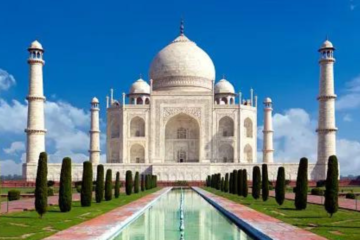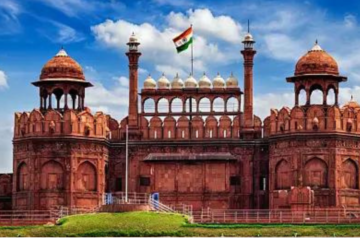
Famously, Shirdi was the place of birth of the saint Shri Sai Baba in the late 1800s. One of the biggest temple organizations is the Shri Saibaba Sansthan Trust, which is located in Shirdi. The saint accepted for his supernatural powers, Shri Sai Baba, lived and lectured for more than fifty years at Shirdi, one of the most well-known places of worship in India. Since those who loved him remain true to his teachings and still respect him, the Samadhi Temple, where he lived contains a room that features objects and items utilized by Shri Sai throughout his lifetime. His mortal remains are also maintained at the temple.
About 60,000 visitors and followers of various religions and communities come to the temple every day, and during holiday seasons, this number increases even more. There is a line to see the statue and pay homage to him when the temple opens at 4:45 a.m. Other locations in Shirdi related to the life of Shri Sai are Dwarkamai Mandir, Chavadi, and Gurusthan.
There is just one more important and similar temple in all of India, which is Dwarkamai Mandir, the home of Baba. The fact that the sacred flame, or dhuni, that Sai Baba started at the Dwarkamai Mandir continues to glow today is an additional fascinating aspect of the place. It is said that the black powder that falls from the Udi dhuni has medicinal properties.
One of Baba’s greatest miracles is believed to be the fact that the neem tree’s leaves are sweet, which is why Baba used to spend a lot of time sitting behind it. Additionally, Baba believes that the Samadhi of his own master is placed in a Gurusthan under a neem tree, which is also the location of Baba’s discovery during his Balyog or Yuva avastha.This is the reason this place is recognized as being so important.

Shirdi, a small town in the Ahmednagar district of Maharashtra, India, is renowned as one of the most significant pilgrimage destinations in the country. It gained prominence due to the presence and teachings of the revered saint, Sai Baba. Shirdi is a place where spirituality, devotion, and cultural heritage come together, attracting millions of devotees and tourists every year. Here’s a comprehensive overview of Shirdi:
1. Spiritual Center:

- Sai Baba Samadhi Mandir: The heart of Shirdi, the Sai Baba Samadhi Mandir, is the final resting place of Sai Baba. Devotees from all over the world visit this temple to seek Sai Baba’s blessings and experience the divine atmosphere. The temple complex includes the main shrine, where Sai Baba’s idol is enshrined, and various other important spots like Dwarkamai and Chavadi.
- Dwarkamai: Dwarkamai is the mosque where Sai Baba lived and performed miracles. It holds immense significance for devotees and is a testament to Sai Baba’s universal teachings.
- Chavadi: Chavadi is the place where Sai Baba used to sleep every alternate night. It has historical and spiritual importance, and devotees visit this spot to pay their respects.
2. Spiritual Practices and Festivals:
- Aarti and Bhajans: The town resonates with the devotional tunes of Aarti and Bhajans throughout the day. These ceremonies create a spiritually uplifting atmosphere for the devotees.
- Festivals: Shirdi celebrates various festivals with grandeur, especially on Sai Baba’s birth anniversary (Sai Jayanti). The town is beautifully illuminated, and processions are carried out, attracting a large number of devotees.
3. Pilgrim Facilities:
- Prasadalaya: Shirdi provides free meals (Prasadam) to thousands of devotees daily. The Prasadalaya ensures that every visitor, regardless of their background, is served with love and devotion.
- Accommodation: Shirdi offers a range of accommodations, from budget hotels to luxurious resorts, ensuring a comfortable stay for pilgrims.
4. Sai Heritage Village:
- Educational and Cultural: Sai Heritage Village is an initiative to educate visitors about Sai Baba’s life, teachings, and the rural culture of the region. It offers a glimpse into Sai Baba’s era and the historical context in which he lived.
5. Shopping and Souvenirs:
- Shopping: Shirdi has numerous shops selling religious artifacts, idols, books, and souvenirs related to Sai Baba. Visitors often buy these items as tokens of their spiritual journey.
6. Universal Appeal:
- Visitors from All Walks of Life: Shirdi is not just a pilgrimage site; it’s a melting pot of diverse cultures and backgrounds. Devotees and tourists from various parts of India and the world visit Shirdi, making it a truly universal destination.
Shirdi, with its tranquil ambiance, deep-rooted spirituality, and the benevolent presence of Sai Baba, continues to be a source of inspiration and solace for millions. It stands as a testament to the enduring power of faith and the universal message of love, peace, and compassion.
Places to Visit in Shirdi:
Shirdi, a town sanctified by the divine presence of Sai Baba, offers a multitude of spiritual and cultural experiences. Here are the must-visit places that enrich the pilgrimage journey for devotees and tourists alike:
1. Sai Baba Samadhi Mandir:

1. Sai Baba in Shri
Known as God incarnate, which means Shri Sai Baba is known as one of the greatest saints ever witnessed in India, having extraordinary powers. (SAI stands for Sakshaat Ishwar) – GOD IS ALL-POWERFUL
Throughout his long career, this strange The term fa lived in Shirdi, where he first appeared as a young man. His love impacted hearts of others, and those who pray and summon him for blessings in times of need continue to do so even after his Samadhi in 1918. HE changed the lives of those who came into contact with him.
Baba said that his goal is to “Give Blessings” to everyone without instance, and he displays this in many kinds of ways by helping people who are sick, protecting lives, and protecting
Baba is considered as a god by his followers. This is based on actual experience rather than fiction. “I view everything equally.”
Sai Baba is unique in that he crosses all religious, caste, and creedal restrictions. He offered the universal religion of love and was the center of all religions.
The Sai is a meeting place for believers of all religions, and Baba’s great affection and respect inspire individuals from all walks of life and communities. Baba showed great regard for his Hindu followers and their metaphysical leaders. He attended to their requirements and let them to worship in accordance with Hindu and other religious customs.
2. Dwarkamai

Dwarkamai is a significant spiritual landmark in Shirdi, Maharashtra, and holds a special place in the hearts of Sai Baba’s devotees. It was the mosque where Sai Baba lived, performed miracles, and shared his teachings. The name ‘Dwarkamai’ means ‘Mother Dwarka,’ symbolizing the universal motherhood of the place, welcoming people of all faiths, backgrounds, and walks of life.
For millions of Shri Sai Baba followers, one of the most loved religious locations is Dwarkamai, an important place of worship located in the Indian state of Maharashtra. It is an essential component of the Shirdi Sai Baba temple complex and is very important to Baba’s followers.
From 1858 until his attainment of samadhi in 1918, Shri Sai Baba lived in Dwarkamai for about sixty years. Baba converted the area, which had been a run-down mosque, into a home for himself and his adherents. The term “Dwarkamai,” which is supposed to have been bestowed by Baba himself, denotes the union of the two religions of Islam and Hinduism.



